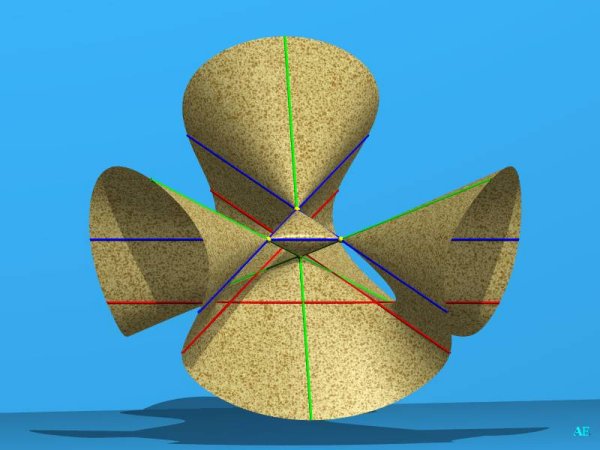
Second form
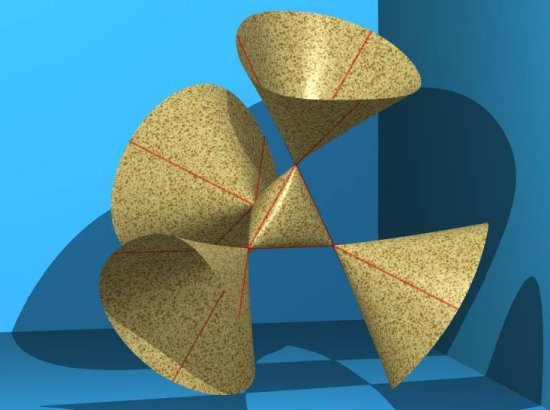
Third form
| next surface | previous surface | 2D curves | 3D curves | surfaces | fractals | polyhedra |
CAYLEY SURAFCE

Second form |

Third form |
| Surface studied by Cayley in 1850.
Arthur Cayley (1821-1895): British mathematician. See the programming with Povray on Alain Esculier's website. |
| Form #1
Homogeneous equation said to be tetrahedral: Cubic surface. The 4 conical points are The 9 lines are the 6 and the 3 In the associated affine version, with equation |
 |
The Cayley surface is the surface defined (up to homography) by the above equation.
It is the only cubic surface for which the homography
group under the action of which it is invariant is the group S4
of permutations of 4 objects (cf. the invariance under the 24 permutations
of the coordinates )
and it is also the only cubic surface to have 4 conical points (maximum
possible for a cubic surface).
This non smooth surface
has 9 lines, which are real: the edges of the tetrahedron formed by the
conical points and 3 other lines, which are coplanar.
A first projective transform enables us to "see" the 9 lines at finite distance:
| Form #2
The change of coordinates defined by Homogeneous equation 2: The conical points are The 9 lines are the 6 edges of the tetrahedron formed by the conical points, plus: Associated affine Cartesian equation: |
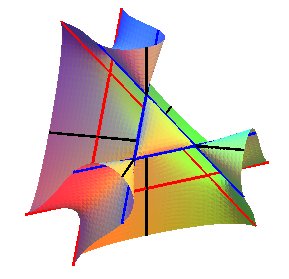 The axes of the frame are in black, the three other edges
of the tetrahedron in blue, and the three lines In this case, it can be proved that the Cayley surface is the locus of the points the projections of which on the four plane-face of the tetrahedron formed by the conical points are coplanar. It is, in some way, the generalization to space of the problem of the locus of the points for which the projections of the sides of a triangle are aligned, such locus being the circumscribed circle of the triangle (cf Simson line). |
A second projective transform gives an affine view in which the surface is invariant under the 24 isometries of the regular tetrahedron (but 3 of the 9 lines are at infinity):
| Form #3
The change of coordinates defined by Homogeneous equation 3: The conical points are The 9 lines are the 6 edges of the tetrahedron and Associated affine Cartesian equation: The conical points are forming a regular tetrahedron the 6 edges of which are the lines The rotation of an eighth of a turn defined by The volume of the tetrahedral part is equal to Under this form, the Cayley surface is a tetrahedral surface of Goursat. |
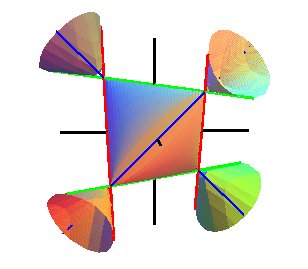 View with the 3 coordinate axes (in black) and the 6 included lines. |
The third projective transform below gives the so-called
"pentahedral" form, that all cubic surfaces have (Sylvester-Clebsch theorem):
| Form #4
The change of coordinates defined by Homogeneous equation 4: The conical points are The nine included lines are the 6 edges of the tetrahedron and Associated affine Cartesian equation: The conical points are With so-called "pentahedral" homogeneous equation in (compare to the pentahedral equation of the Clebsch surface). |
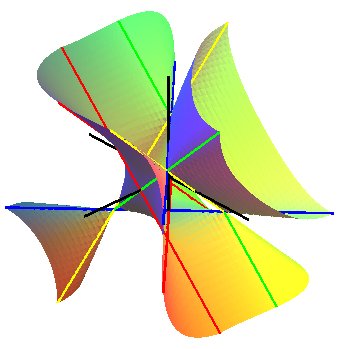
View with the 6 edges of the tetrahedron (in blue, yellow,
and green) and the three lines Link to an applet allowing to manipulate the figure formed by the lines included in the surface. |
Do not mistake for the ruled Cayley surfaces.
View of the form #2 made by Alain Esculier, the surface was scaled in one direction so that the central tetrahedron is regular
View of the form #4 made by Alain Esculier
View of the form #3 ;
in pink, the sections by the 3 coordinate planes, which are circles.
On the right, composition of two surfaces (anaglyph 3D image to be
looked at with red/cyan glasses).
| next surface | previous surface | 2D curves | 3D curves | surfaces | fractals | polyhedra |
© Robert FERRÉOL Alain ESCULIER 2017